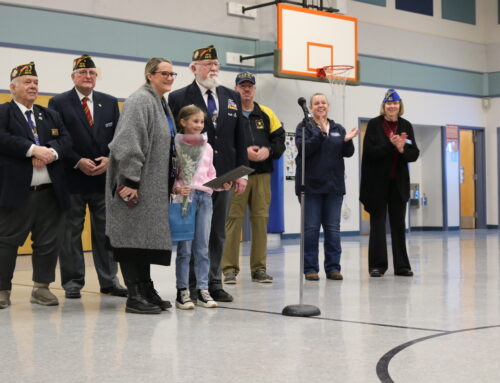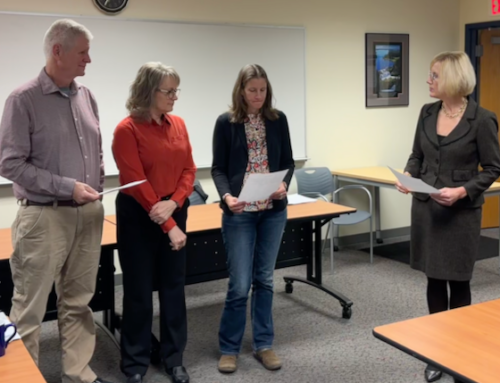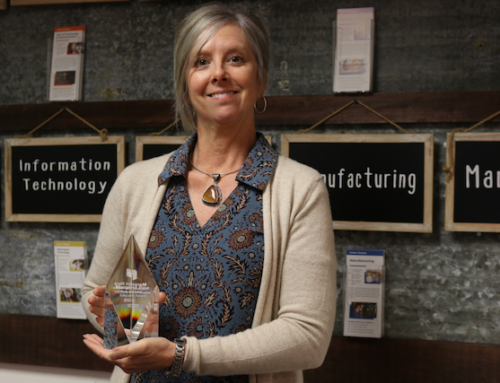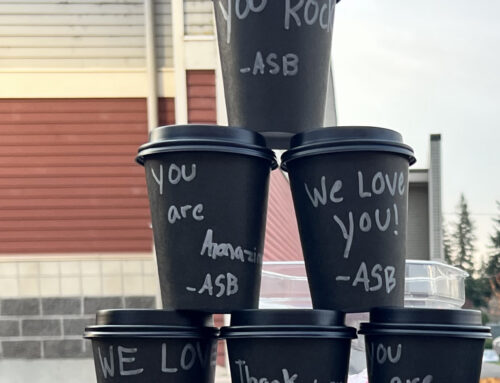Columbia River Gorge Elementary Music teacher, Amy Switzer, stands alone in her classroom in front of her computer screen filled with tiles of smiling first grade students. She leads them in the Good Morning song complete with hand clapping and stomping. When asked for suggestions on other movements they can do, student hands fly into the air. Gideon is called on, unmuted and suggested adding hopping to the song. Another verse is sung.
“It’s great to see the students once a week in live zoom lessons,” said Switzer. “I really miss them!” Since traditional elementary music class is such a participatory, whole-group experience, Switzer said it was a challenge to figure out how to accomplish music goals remotely. “Kindy, 1st and 2nd Grades traditionally spend time exploring music through singing, listening and moving,” she said. “I have found it is possible for me to continue much of that in Zoom Music Class.”
In addition to Zoom Classroom, the SeeSaw educational app is an effective tool allowing students to create videos and other multimedia items. “Our first SeeSaw lesson was a musical scavenger hunt to find things they could shake, hit or scrape and collect in a box to use in music class,” Switzer said. “Then ‘Ta da!’ They now have their own instruments to practice playing steady beats and rhythm in Zoom Music Class.”
Switzer’s music lessons have become more project based with upper grade level students. For example, her 3rd, 4th and 5th grades have started a project called the “World Music Tour.” Their Google Classroom assignment is to interview an adult in their family or adult of their choice to see what continents and countries their ancestors came from and do they know any songs that have been passed down in their family. “Once the information is collected, we will ‘visit’ those places through music,” Switzer explained. “It has been so much fun getting to know my students through this project!”
In fact, knowing students better has been one of the surprising benefits that Switzer has seen. “It is nice to connect with each and every student who participates in Seesaw and Google classroom,” she said. “I get the chance to see and read their work in depth. I really enjoy seeing and reading each and every one of their assignments and can respond to them with thoughtful feedback. Some students also find they are braver when communicating with teachers through Google Classroom.”
Switzer’s students are reacting positively to the idea of remote learning music classes. “They are so grateful to have live special subject classes again,” she said. “For some students, special subjects can be the reason they get up and go to school.”
But still, it has been tough for her to not be able to see her students in person. “It’s also hard not being able to have kids up and moving around interacting together playing singing games, recorders, band instruments, choir, ukuleles, and Orff instruments and experiencing the language of music,” she said.
Teaching music remotely presents many challenges, but Switzer said she is fortunate to have the support of the WSD elementary music team. “Becky, Anna, Frank and I are a strong team,” she said. “We each have our strengths and collectively we help each other figure this out. We spend each week brainstorming and sharing ideas. We communicate through email daily and try out new approaches on each other before trying with students. They have been my rock through this whole experience.”
When asked if music class can play a role in helping students cope with the situation around remote learning, Switzer said she believes music gives students connections to the world they live in and to each other. “It takes them to creative places in their brain that other activities cannot,” she said. “Music is a powerful antidote that can relieve anxiety and get our minds back in an even rhythm to cope with whatever life throws at us. Kids too.”
A student gave Switzer a plaque that read: Music is life, that’s why our hearts have beats. “You don’t have to understand that to experience it,” she explained. “Our work is called ‘play’ for a reason. It’s important to visit that part of who we are, especially for growing and developing minds.”






